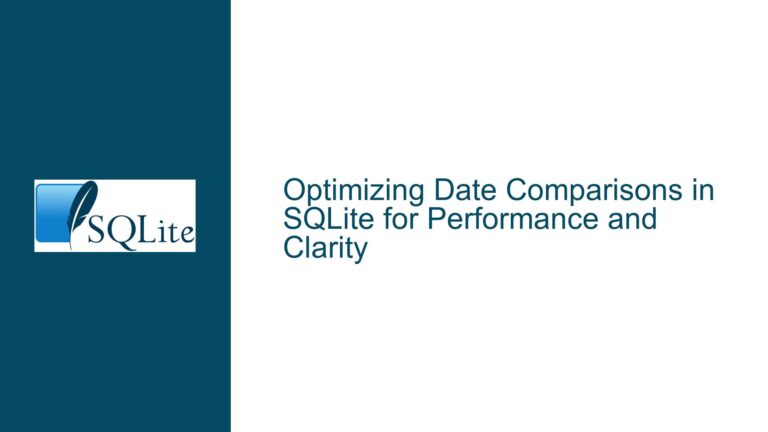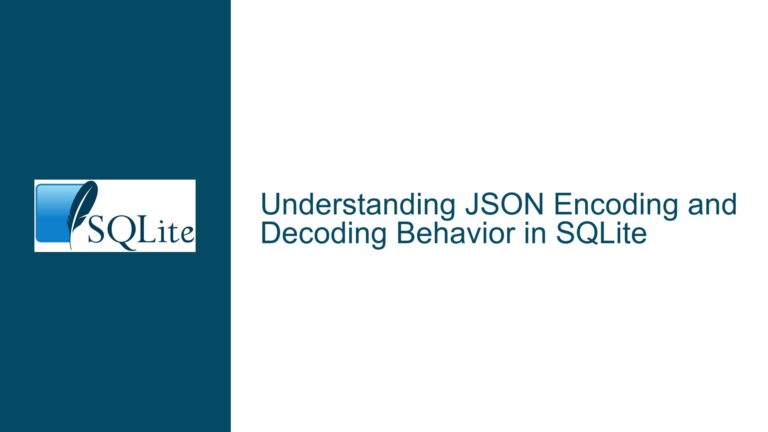FTS5 External Content Table Search Failure Due to Unpopulated Trigram Index
Understanding FTS5 External Content Table Indexing Behavior
The core challenge arises when implementing full-text search with SQLite’s FTS5 extension using external content tables configured with trigram tokenization. Developers frequently encounter empty search results despite confirming base table data visibility through simple SELECT queries. This occurs because FTS5 external content virtual tables operate fundamentally differently from standard FTS5 tables – they require explicit population and maintenance of their search indexes through separate data insertion mechanisms rather than automatic synchronization.
When configured with content=’test’ and content_rowid=’id’, the FTS5 virtual table becomes a read-only interface that references data stored externally in the ‘test’ table. However, the n-gram token index used for pattern matching exists independently within the FTS5 table’s internal storage structures. The CREATE VIRTUAL TABLE statement only establishes metadata relationships between the FTS5 table and source data – it does not automatically populate the trigram index. This architectural separation creates a situation where queries against the FTS5 table can display raw data (when using unconstrained SELECT *) but fail to return search results because the underlying token index remains empty until explicitly populated through INSERT operations or trigger-based automation.
Critical Misunderstandings in External Content Table Management
1. Index Population Assumption Fallacy
The most prevalent misconception is that specifying content= and content_rowid= parameters during FTS5 table creation automatically synchronizes both data and search indexes. In reality, these parameters only configure data source relationships – actual index population requires separate INSERT statements that copy content from the external table into the FTS5 index structure. This process converts source text into trigram token sequences stored in optimized search structures.
2. Trigger Dependency Oversight
Live synchronization between base table modifications and FTS5 indexes requires explicit trigger creation. Without AFTER INSERT/UPDATE/DELETE triggers on the source table that mirror changes to the FTS5 table, the search index becomes stale immediately after initial population. This leads to decreasing search accuracy over time as data diverges between the source table and FTS5 index.
3. Tokenization Configuration Errors
Improper trigram tokenizer configuration can prevent index population from generating usable search patterns. The tokenize=’trigram’ parameter must be correctly specified in the CREATE VIRTUAL TABLE statement with valid syntax. Missing quotes or incorrect parameter formatting causes silent fallback to default tokenization, rendering trigram pattern matching inoperable despite apparent successful table creation.
4. RowID Mapping Misconfiguration
Incorrect content_rowid= specification breaks the relationship between FTS5 internal row identifiers and source table primary keys. This manifests as partial or complete index population failures, where INSERT INTO fts SELECT… statements either abort or create malformed index entries that don’t properly reference source records.
5. Search Query Syntax Conflicts
Using incompatible search operators with trigram tokenization produces false negatives. The FTS5 MATCH operator requires different syntax patterns when using trigrams compared to standard tokenizers. Developers often attempt phrase searches or proximity operators that aren’t compatible with the trigram tokenizer’s pattern matching capabilities.
Comprehensive Index Population and Maintenance Strategies
1. Initial Index Population Procedure
After creating the FTS5 virtual table with external content configuration, explicitly populate the search index using an INSERT-SELECT statement that mirrors the source table’s structure:
INSERT INTO fts(rowid, data)
SELECT id, data FROM test;
This operation extracts text from the ‘test.data’ column, generates trigram tokens, and builds the optimized search index. Verify successful population by checking the internal ‘fts_data’ shadow table:
SELECT COUNT(*) FROM fts_data WHERE col=0;
A non-zero result confirms trigram index entries exist. For tables exceeding 1MB, consider chunked insertion using LIMIT and OFFSET to prevent memory overconsumption.
2. Trigger-Based Synchronization Implementation
Create database triggers that maintain index consistency after source table modifications:
-- Insert trigger
CREATE TRIGGER test_ai AFTER INSERT ON test
BEGIN
INSERT INTO fts(rowid, data) VALUES (NEW.id, NEW.data);
END;
-- Update trigger
CREATE TRIGGER test_au AFTER UPDATE ON test
BEGIN
INSERT INTO fts(fts, rowid, data) VALUES ('delete', OLD.id, OLD.data);
INSERT INTO fts(rowid, data) VALUES (NEW.id, NEW.data);
END;
-- Delete trigger
CREATE TRIGGER test_ad AFTER DELETE ON test
BEGIN
INSERT INTO fts(fts, rowid, data) VALUES ('delete', OLD.id, OLD.data);
END;
These triggers handle incremental index updates by converting SQL operations on ‘test’ into corresponding FTS5 index modifications. Use EXPLAIN INSERT… to analyze trigger performance characteristics and consider batch processing for high-volume update scenarios.
3. Manual Index Rebuilding Techniques
For development environments or small datasets, utilize the FTS5 rebuild command to completely reconstruct the search index:
INSERT INTO fts(fts, rank) VALUES ('rebuild', 1);
This deletes existing trigram tokens and re-populates the index from the current state of the ‘test’ table. Combine with PRAGMA journal_mode=OFF and PRAGMA synchronous=OFF during rebuilds to accelerate processing for large datasets.
4. Query Syntax Optimization for Trigram Search
Modify search patterns to leverage trigram tokenization effectively. Instead of using phrase matching:
-- Ineffective with trigrams
SELECT * FROM fts WHERE data MATCH '"foo bar"';
-- Effective trigram search
SELECT * FROM fts WHERE data MATCH 'foo AND bar';
Implement prefix search using the trigram wildcard pattern:
SELECT * FROM fts WHERE data MATCH 'fo*';
This translates to scanning for trigrams starting with ‘fo’ followed by any third character. Use EXPLAIN and QUERY PLAN to analyze search pattern efficiency.
5. Index Consistency Validation Protocol
Develop a diagnostic routine to verify FTS5 index integrity:
-- Compare record counts
SELECT COUNT(*) FROM test;
SELECT COUNT(DISTINCT rowid) FROM fts;
-- Check text consistency
SELECT t.id, t.data, f.data
FROM test t LEFT JOIN fts f ON t.id = f.rowid
WHERE f.data IS NULL OR f.data != t.data;
Implement periodic consistency checks using these queries, particularly after bulk data loading operations. For databases with strict integrity requirements, wrap modification operations in transactions that verify FTS5 index updates before committing.
6. Performance Tuning for Large-Scale Deployments
Optimize FTS5 storage parameters when working with multi-gigabyte datasets:
CREATE VIRTUAL TABLE fts USING fts5(
data,
content='test',
content_rowid='id',
tokenize='trigram',
prefix='2,3,4', -- Optimize for 2/3/4-character searches
columnsize=0 -- Disable separate column storage
);
Adjust the prefix parameter based on common search pattern lengths. Set columnsize=0 when only needing search capabilities without direct column value retrieval from the FTS5 table. Configure custom tokenizer parameters to balance index size and search accuracy:
tokenize='trigram case_sensitive 1'
7. Advanced Recovery from Index Corruption
Address index corruption scenarios using a multi-phase recovery process:
- Export current FTS5 configuration:
SELECT sql FROM sqlite_master WHERE name='fts';
- Dump existing content:
ATTACH DATABASE 'backup.db' AS bak;
CREATE TABLE bak.fts_content AS SELECT rowid, * FROM fts;
- Rebuild the virtual table:
DROP TABLE fts;
-- Recreate using original CREATE statement
INSERT INTO fts(rowid, data) SELECT id, data FROM test;
- Validate using checksum comparisons between source and rebuilt indexes.
8. Hybrid Indexing Architectures
For environments requiring both full-text search and conventional querying, implement a dual-index strategy:
CREATE VIRTUAL TABLE fts_trigram USING fts5(
data,
content='test',
content_rowid='id',
tokenize='trigram'
);
CREATE INDEX test_data_prefix ON test(data COLLATE NOCASE);
This combines trigram-based fuzzy searching with traditional B-tree indexes for exact matches and prefix searches. Route queries to the appropriate index based on search pattern characteristics.
9. Monitoring and Alerting Integration
Implement proactive monitoring of index health metrics:
-- Track index growth anomalies
SELECT COUNT(*) AS fts_entries FROM fts_data;
-- Monitor trigger execution counts
SELECT name, count FROM sqlite_stats WHERE tbl='fts';
-- Measure search latency
.timer ON
SELECT * FROM fts WHERE data MATCH 'foo' LIMIT 1;
Set thresholds for critical metrics like index-to-source size ratios and trigger invocation frequency. Integrate with application logging systems to alert administrators when anomalies exceed configured limits.
10. Migration Strategies from FTS4/Other Systems
Develop phased migration plans when transitioning from legacy FTS implementations:
- Create parallel FTS5 tables alongside existing indexes
- Implement trigger-based dual updates during transition
- Gradually shift read queries to use FTS5 tables
- Conduct performance benchmarking at each stage
- Decommission legacy indexes after verification
Use SQLite’s ATTACH DATABASE command to facilitate cross-database comparisons during migration validation phases.






